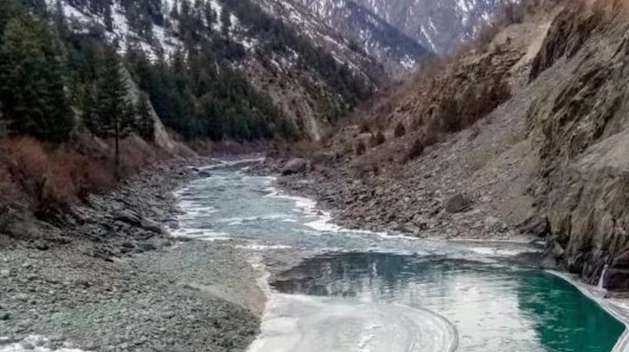
India’s Cabinet Committee on Security (CCS) on Wednesday suspended the decades-old Indus Waters Treaty with Pakistan indefinitely, a day after a terror attack in Jammu and Kashmir’s Pahalgam town killed 26 people. The Resistance Front (TRF), an offshoot of the Pakistan-based Lashkar-e-Taiba group, is believed to be responsible for the strike.
With this, the water supply from the Indus River and its distributaries—the Jhelum, Chenab, Ravi, Beas, and Satluj—will be stopped. These rivers are the water supply for Pakistan, impacting tens of millions of people in that country.
In 2019, too, after the Pulwama terror attack against paramilitary personnel, Prime Minister Narendra Modi reportedly told the Cabinet Committee on Security that “blood and water can’t flow together." But at the time, India chose not to implement it.
India and Pakistan signed the Indus Waters Treaty in 1960, with the World Bank as an additional signatory. The pact sought to divide the water of the Indus river and its tributaries equitably between the two countries. Under the treaty, water from three eastern rivers—Beas, Ravi, and Sutlej—was allocated to India, and that from the three western rivers—Chenab, Indus, and Jhelum—to Pakistan.
The treaty also permits both countries to use the other’s rivers for certain purposes, such as small hydroelectric projects that require little or no water storage.
The treaty gives control over the waters of the three “Eastern Rivers"—the Beas, Ravi, and Sutlej, located in India with a mean annual flow of 41 billion m3 (33 million acre⋅ft)—to India, while control over the waters of the three “Western Rivers"—the Indus, Chenab, and Jhelum, located in India with a mean annual flow of 99 billion m³—to Pakistan.
India got about 30% of the total water carried by the Indus River System located in India, while Pakistan got the remaining 70%.
The treaty allows India to use the water of Western Rivers for limited irrigation use and unlimited non-consumptive uses such as power generation, navigation, floating of property, fish culture, etc. It lays down detailed regulations for India in building projects over the Western Rivers.
The preamble of the treaty recognises the rights and obligations of each country for the optimum water use from the Indus System of Rivers in a spirit of goodwill, friendship, and cooperation.
However, India derives military advantage out of IWT as its scope is confined to the Indus system of rivers (both eastern and western rivers) basin area located in India and only Ravi and Sutlej basins located in Pakistan per Articles II (1 to 4) and III (2 to 3) and the IWT deals only with the sharing of water available/flowing in Indian part between Pakistan and India. As per the IWT, Pakistan bombing/destroying dams, barrages, power stations, etc, located in the Indian part of the Indus system of rivers is a violation of the treaty, which can lead to abrogation of IWT.
The treaty has largely ensured peace over water sharing, but there has been a long-standing dispute over the Kishanganga and Ratle hydroelectric projects, both located in the union territory of Jammu and Kashmir.
The Kishanganga project, in Bandipora district across the Kishanganga river, which is a tributary of the Jhelum river, was inaugurated in 2018. The Ratle hydroelectric project, over the Chenab river in Kishtwar district, is currently under construction.
Pakistan has raised concerns about the design of the Indian dams, meant for power generation, which it claims will obstruct the flow of the rivers that provide water for 80% of its irrigated crops, thereby accusing India of violating the treaty.
An interim order by a court of arbitration in 2013 had allowed India to resume construction of the Kishanganga dam. The order noted that preventing the diversion of water would have to be based on Pakistan’s demonstrated utilisation, which it did not have when the dispute began. But Islamabad says its concerns are important because water from the tributaries, which is used for irrigation, is necessary for food security and the country’s economic and social stability.
This year, the Permanent Court of Arbitration, situated in The Hague, Netherlands, endorsed the Indian government’s stand and ruled that the World Bank-appointed neutral expert “is competent" to decide on the design and water usage by two hydropower projects in Jammu and Kashmir under the provisions of the Indus Waters Treaty.
The ruling came on the petition of Pakistan, which approached the court against the Kishanganga and Ratle Hydroelectric Project in Kashmir. India opposed this, as it insisted on the matters to be resolved through a World Bank-appointed neutral expert.
Downstream, some of Pakistan’s biggest dams, such as Mangla, are built on the Jhelum River. They produce a substantial proportion of Pakistan’s electricity.
Though the treaty is in no way connected with the security aspects of both nations, Pakistan, being a downstream nation of both Eastern and Western Rivers, fears that India could potentially create floods or droughts in Pakistan, especially in times of warlike situations.
In 1948, during the Indo-Pakistani War of 1947–1948, the water rights on the river system were the focus of an Indo-Pakistani water dispute. Since the ratification of the treaty in 1960, India and Pakistan have not engaged in any water wars, despite engaging in several military conflicts. Most disagreements and disputes have been settled via legal procedures provided for within the framework of the treaty.
The Indus Waters Treaty was once considered one of the most successful water-sharing endeavours in the world, even though analysts acknowledge the need to update certain technical specifications and expand the scope of the agreement to address climate change.